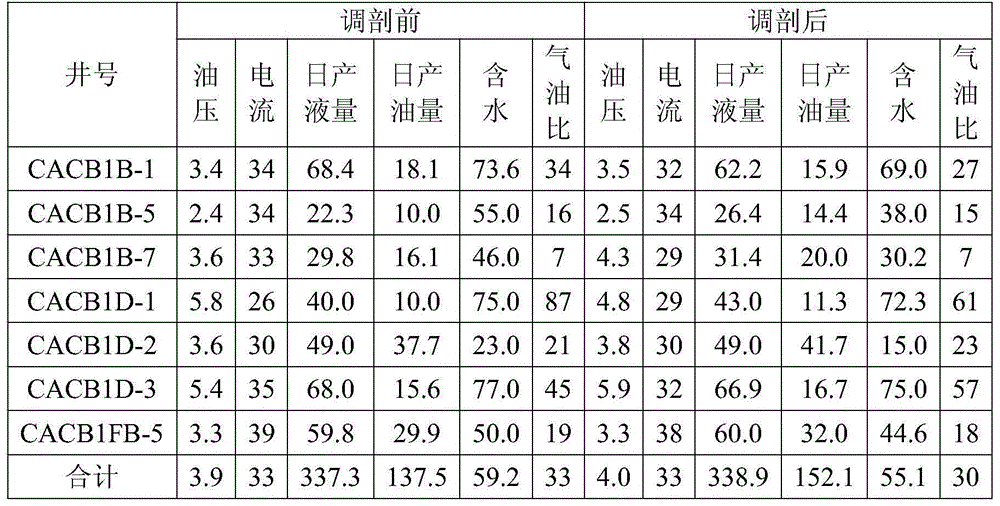Anionic polyacrylamide water-in-water emulsion water shutoff profile control agent, and preparation method and using method thereof
A polyacrylamide, water-in-water emulsion technology, applied in chemical instruments and methods, drilling compositions, etc., can solve the problems of long dissolution time, high energy consumption, too fast cross-linking time, etc.
- Summary
- Abstract
- Description
- Claims
- Application Information
AI Technical Summary
Problems solved by technology
Method used
Image
Examples
Embodiment 1
[0027] Add 108.8g of deionized water, 32.4g of acrylamide, 44g of ammonium sulfate, 5.58g of acrylic acid, 10g of stabilizer, and 0.02g of EDTA into a 250mL four-neck flask equipped with stirring, nitrogen tube, and thermometer, and start stirring at a stirring speed of 200 rpm / min, add 8g of anhydrous sodium sulfate, and adjust the pH value of the system to 7 with sodium hydroxide solution. Raise the temperature to 30°C, pass nitrogen for 30 minutes, then add 0.013g of sodium bisulfite, and then add 0.025g of ammonium persulfate after 5 minutes, the reaction starts in about 15 minutes, and the viscosity of the system increases as the reaction progresses. To a certain extent, add 5g of ammonium sulfate and 5g of anhydrous sodium sulfate. Viscosity gradually decreased, and the system was milky white. When kept at 45°C for 12 hours, a milky white emulsion with rotational viscosity of 280mPa·s was obtained. In 1mol / L sodium chloride aqueous solution, its intrinsic viscosity was ...
Embodiment 2
[0029] Add 108.8g of deionized water, 32.4g of methacrylamide, 44g of ammonium sulfate, 5.58g of acrylic acid, 10g of stabilizer, and 0.02g of EDTA into a 250mL four-neck flask equipped with a stirring, nitrogen tube, and thermometer. 200 rpm, add 8g of anhydrous sodium sulfate, and adjust the pH value of the system to 7 with sodium hydroxide solution. Raise the temperature to 30°C, pass nitrogen for 30 minutes, then add 0.013g of sodium bisulfite, and then add 0.025g of ammonium persulfate after 5 minutes, the reaction starts in about 15 minutes, and the viscosity of the system increases as the reaction progresses. To a certain extent, add 5g of ammonium sulfate and 5g of anhydrous sodium sulfate. Viscosity gradually decreased, and the system was milky white. When kept at 45°C for 12 hours, a milky white emulsion with rotational viscosity of 315mPa·s was obtained. In 1mol / L sodium chloride aqueous solution, its intrinsic viscosity was 385mL / g.
Embodiment 3
[0031] Add 108.8g of deionized water, 32.4g of acrylamide, 44g of ammonium sulfate, 2.88g of acrylic acid, 2.7g of 2-acrylamido-2-methylpropane into a 250mL four-necked flask equipped with stirring, nitrogen tube, and thermometer Sulfonic acid, 10g stabilizer, 0.02g EDTA start stirring, stirring speed 200 rpm, add 8g anhydrous sodium sulfate, adjust the pH value of the system to 7 with sodium hydroxide solution. Raise the temperature to 30°C, pass nitrogen for 30 minutes, then add 0.013g of sodium bisulfite, and then add 0.025g of ammonium persulfate after 5 minutes, the reaction starts in about 15 minutes, and the viscosity of the system increases as the reaction progresses. To a certain extent, add 5g of ammonium sulfate and 5g of anhydrous sodium sulfate. The viscosity gradually decreased, and the system was milky white. When it was kept at 45°C for 12 hours, a milky white emulsion with a rotational viscosity of 360mPa·s was obtained. In 1mol / L sodium chloride aqueous solut...
PUM
| Property | Measurement | Unit |
|---|---|---|
| Rotational viscosity | aaaaa | aaaaa |
| Intrinsic viscosity | aaaaa | aaaaa |
| Intrinsic viscosity | aaaaa | aaaaa |
Abstract
Description
Claims
Application Information
 Login to View More
Login to View More - R&D
- Intellectual Property
- Life Sciences
- Materials
- Tech Scout
- Unparalleled Data Quality
- Higher Quality Content
- 60% Fewer Hallucinations
Browse by: Latest US Patents, China's latest patents, Technical Efficacy Thesaurus, Application Domain, Technology Topic, Popular Technical Reports.
© 2025 PatSnap. All rights reserved.Legal|Privacy policy|Modern Slavery Act Transparency Statement|Sitemap|About US| Contact US: help@patsnap.com

